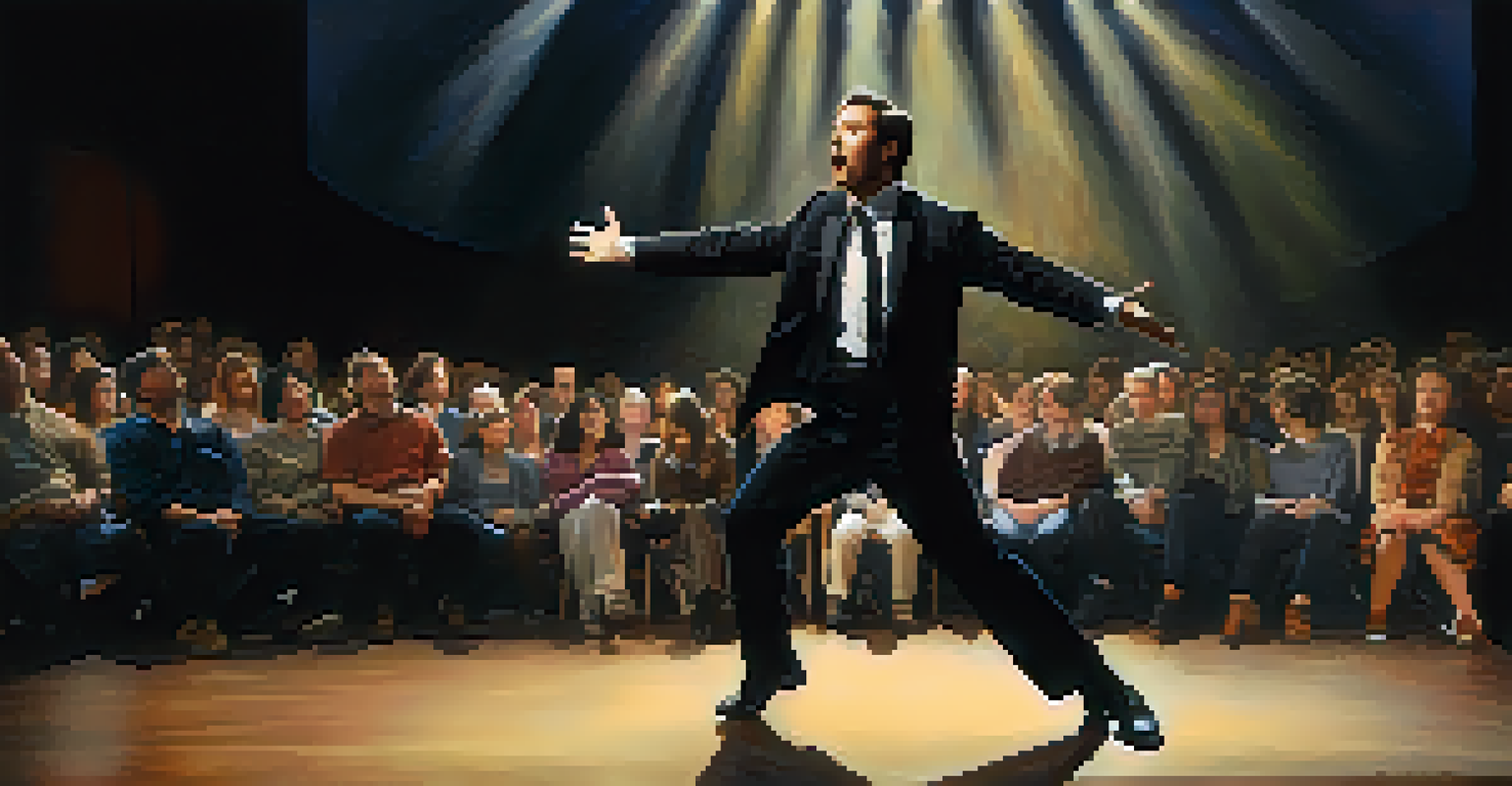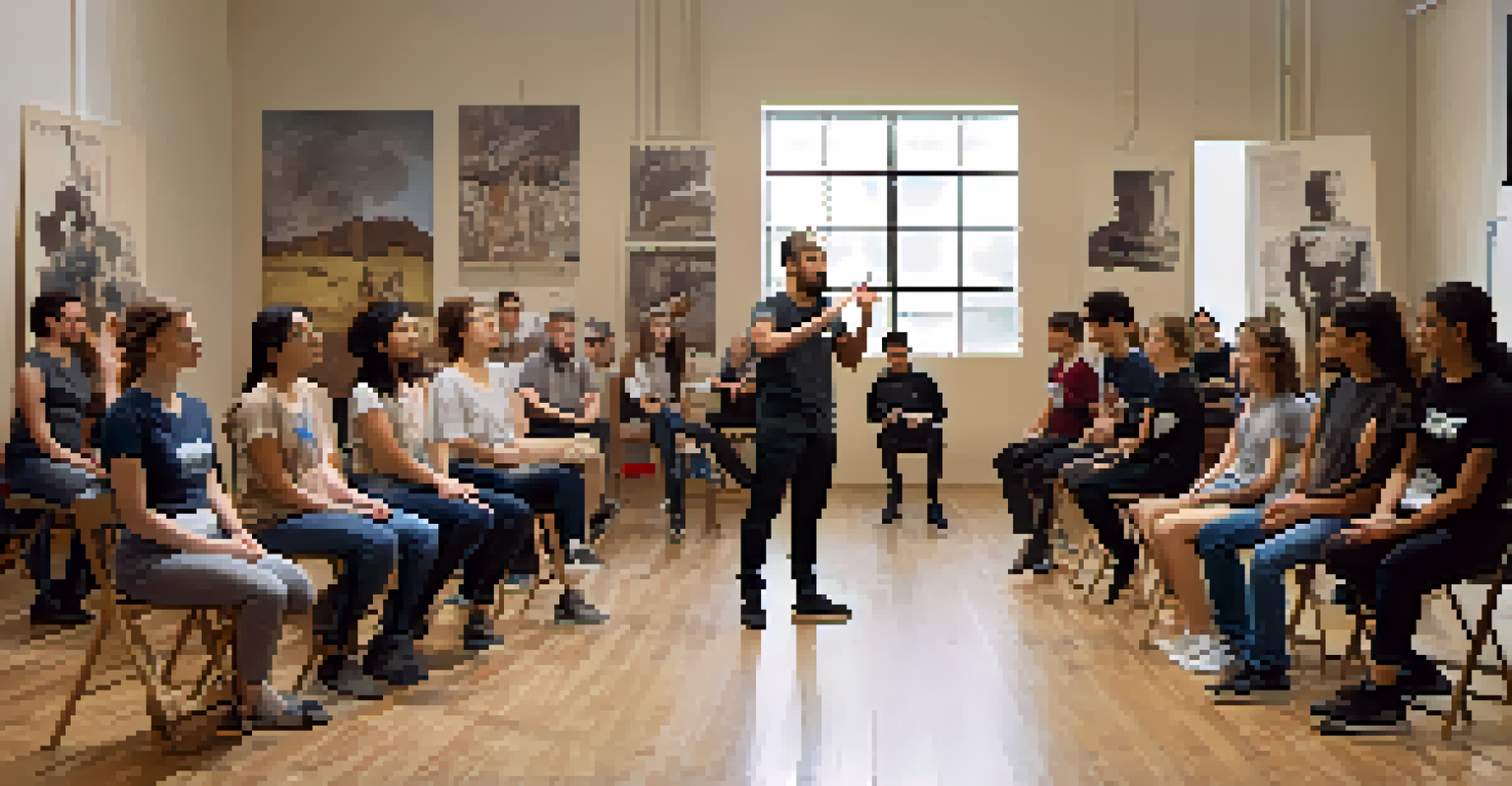Breath Control Techniques for Actors During Rehearsals

Understanding the Importance of Breath Control in Acting
Breath control is a fundamental skill for actors that enhances both vocal projection and emotional expression. Just as a musician must master their instrument, an actor must understand how to use their breath to convey character and intention. Proper breathing not only helps with delivering lines but also supports physical presence on stage or in front of the camera.
Acting is behaving truthfully under imaginary circumstances.
When you control your breath, you gain control over your emotions and reactions. This is crucial during rehearsals, where maintaining a character’s emotional state can be challenging. Think of breath as the bridge between your mind and body; it allows you to stay grounded and focused, even in the most intense scenes.
Actors who neglect breath control may find themselves struggling with nerves or fatigue, which can affect their performance. By understanding and practicing breath control techniques, actors can create a more profound connection with their audience, making each performance more impactful.
Simple Breathing Exercises to Enhance Control
One effective exercise is the '4-7-8' breathing technique, which involves inhaling for four seconds, holding the breath for seven seconds, and exhaling for eight seconds. This method helps calm the mind while strengthening the diaphragm, a key muscle used in breath control. It’s a great way to start any rehearsal, helping actors settle into their bodies and focus on their roles.

Another useful exercise is 'diaphragmatic breathing.' To practice this, lie on your back with a book on your stomach. As you breathe in deeply, the book should rise, and as you exhale, it should fall. This visual cue reinforces the importance of engaging the diaphragm rather than just the chest, promoting deeper and more controlled breaths.
Breath Control Enhances Performance
Mastering breath control allows actors to improve vocal projection and emotional expression, creating a deeper connection with their audience.
Incorporating humming into your warm-up can also be beneficial. Humming engages the vocal cords while encouraging a relaxed state, which is perfect for actors preparing to deliver lines. It’s not only fun but also helps in finding the right pitch and resonance.
Using Breath Control to Convey Emotion
Breath can significantly affect the emotions portrayed on stage. For instance, short, quick breaths often signal anxiety or excitement, while slow, deep breaths can convey calmness or sadness. By being aware of how your breath patterns change with different emotions, you can use this knowledge to enhance your character’s portrayal.
Breath is the bridge which connects life to consciousness, which unites your body to your thoughts.
During rehearsals, practice aligning your breath with your character's emotional journey. This means adjusting your breath as the scene shifts from tension to release. Actors often find that when they consciously manage their breath, it leads to more authentic performances that resonate with the audience.
Consider how certain characters might breathe differently based on their circumstances. A hero facing a daunting challenge may breathe more rapidly, while a villain might have a controlled and steady breath, evoking confidence. This attention to breath not only enriches your performance but also adds layers to your character.
Integrating Breath Control with Movement
Breath control is not just about speaking; it’s also about movement. When actors move around the stage, their breath must flow seamlessly with their actions. For example, when you're running during a scene, maintaining a rhythm with your breath can help you stay grounded and in character, even when physically exerted.
During rehearsals, try coordinating your breath with your movements. For instance, inhale as you prepare for an action and exhale during the execution. This synchronization helps maintain energy levels and allows for a more dynamic performance.
Breathing Exercises for Actors
Incorporating exercises like the '4-7-8' technique and diaphragmatic breathing helps actors develop better breath control and focus.
Additionally, consider how different movements can affect your breath. Slow, deliberate movements may warrant deeper breaths, while fast-paced actions might require quick, shallow breaths. By being mindful of these dynamics, actors can enhance their physicality while remaining vocally strong.
Breath Control Techniques for Monologues
Monologues can be particularly challenging when it comes to breath control, as they require sustained focus and emotional depth. One technique is to break the text into natural breath points, allowing yourself to pause and take a breath without losing the emotional thread. This creates a more engaging rhythm that resonates with the audience.
Practice delivering your monologue while consciously monitoring your breath. This may mean taking deeper breaths at key emotional moments or using shorter breaths to heighten tension. By making these adjustments, your performance will feel more nuanced and intentional.
Recording yourself while performing a monologue is another effective way to analyze your breath control. Listening back allows you to identify areas where you might be rushing or losing breath, giving you the chance to refine your technique before the actual performance.
Creating a Personalized Breathing Routine
To truly master breath control, it's essential to develop a personalized breathing routine that fits your unique needs as an actor. Start by assessing your current breathing patterns during rehearsals and performances to identify areas for improvement. This reflection will help you create a tailored routine that addresses your specific challenges.
Incorporate various breathing exercises into your routine, focusing on both relaxation and vocal strength. Consider setting aside time before rehearsals to practice, allowing you to enter the space with a calm and focused mindset. Consistency is key; the more you practice, the more natural these techniques will become.
Professional Guidance is Key
Seeking professional coaching can provide personalized feedback and advanced techniques, elevating an actor's breath control and overall performance.
Additionally, don't hesitate to adapt your routine as you grow as an actor. What works for you now may change with different roles or experiences. Keep experimenting with different techniques and exercises to find what helps you maintain optimal breath control throughout your acting journey.
Seeking Professional Guidance for Advanced Techniques
While self-practice is invaluable, seeking professional guidance can take your breath control to the next level. Working with a vocal coach or acting teacher who specializes in breath techniques can provide personalized feedback and advanced exercises tailored to your needs. They can help you understand the nuances of breath control that you might miss when practicing alone.
Group classes or workshops focused on breath work can also be beneficial. These settings allow you to learn from others while receiving constructive criticism on your technique. Collaborating with fellow actors not only enhances your skills but also fosters a supportive environment where you can grow together.

Ultimately, investing time in professional training can lead to significant improvements in your performance. The insights gained from experienced practitioners can empower you to experiment with new methods, helping you discover a deeper connection between your breath and your acting.